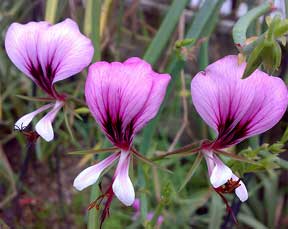If there ever was a division of plants in any family truly mixed up, it most certainly is the pelargonium division of the geranium family. The group is gigantic in numbers, weird in some of the plant and flower formations, and exotic in leaf patterns and texture. When a large collection is viewed in a garden or a lath house, one comes away with the feeling that he has seen something out of this world.
Many of the blooms as well as the plant forms, are fantastic. They almost defy the powers of a Hollywood script writer to describe them. Their make-up and colorings are indefinable. These plants are real collectors’ items for their bloom alone, yet many of them, such as Pelargonium tetragonum, have weird shapes. The finding of them alone will taunt any collector.
However, many of them have a bad habit of going dormant just when you want to show them off. Such species as pelargonium stapletoni and pelargonium echinatum look like something the cat dragged in when they are dormant. In that state they are far from choice, being just a collection of dead-looking sticks that grow out from a central root. Each stick seems to be full of a million thorns. When in full bloom they merit the name of sweetheart geranium because of the little hearts that appear in part of the petals.

Pelargonium gibbosum has many of the same characteristics when dormant except that it does not have thorns. Its claim to distinction is the almost chartreuse color of the flowers. It would be difficult to give a complete list of these exotic ones but to start out try pelargonium glaucifolium, pelargonium crithmifolium and pelargonium carnosum. Perhaps the easiest of these native South African pelargoniums to handle is pelargonium jatrophaefolium, the original pheasants-foot. It adapts itself to life in a pot very easily, and after you get it established you have a plant to enjoy forever.
Perhaps the most unique members of the pelargoniums that are worth hunting down are those called poinsettia, or cactus-flowered, geraniums. They get this name from the twisted flower petals that someone thought looked as though it might be a variety poinsettia (Actually they do look like miniatures of a new poinsettia that was developed years ago.)
Some of the finest and most colorful pelargoniums are to be found in the group of fancy-leaved geraniums. Another group for the collector’s attention-are the carnation-flowered types found in P. hortorum. The scented-leaf geraniums have always been a collector’s item and some of the most interesting of the scented-leaf geraniums are found in the oak-leaved group. (Name refers to the resemblance of the leaves to those of the oak tree.) They are very attractive and have pungent woody scents. Leaves vary from very small to the unusually large ones. Another interesting scented geranium is known as P. tomentosum. It is strongly mint scented with large velvety and hairy leaves. This can be grown in a hanging basket or trained flat on a trellis.
Those of the group known as rosebud geraniums, because the flowers resemble miniature roses, are worthy of anyone’s attention, although they may be difficult to find. Another unusual group is that of the birds-egg geraniums, although they are not nearly as striking as some. At one time the French grew many types of these plants which get their name from the spots of deeper coloring on the flower petals. These spots make one think of freckles.
No article on interesting geraniums would be complete without mention of a few of the miniatures. This race of geraniums is the finest thing in all the geranium family, whether you are collecting them or using them in patio or porch boxes. It would be very hard to grow these plants too large for even a small window sill, as most of them are less than 8 inches high. There are hundreds of other fascinating plants that one could add to a collection of the great pelargonium division of the geranium family. However, if one were to select a single variety from each group mentioned, the collection would be very interesting and well worth the making.
